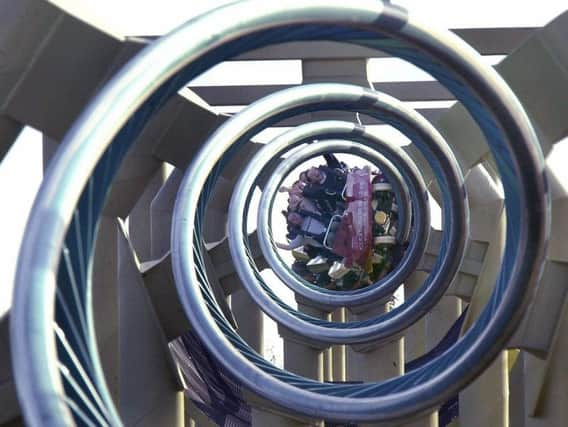Thrilling through the ages: The fascinating history of the modern roller coaster


There are few things more exhilarating, or - depending on your constitution - pant-filling, than hurtling through the air at 100 miles an hour, held in place solely by a metal bar, and periodically turning upside-down.
It sounds mad, and in many ways it is, but roller coasters have now carved themselves a niche as a linchpin of modern leisure.


Health and safety
Advertisement
Hide AdAdvertisement
Hide AdGiven that engineering was, at one time in our history, predominantly based on trial and error, you could be forgiven for expecting the story of the roller coaster to be marked by lack of regulation and gruesome tragedies. In fact, the bloodbaths seen in films like Final Destination 3, where mass derailments lead to scores of fatalities, have never really happened in real life.
The biggest roller coaster disaster in history took place in Battersea Park, London, in 1972, when an appalling accident on the big dipper sent five children plunging to their deaths. For the second worst you have to travel back to Omaha, 1930, when another big dipper malfunctioned, killing four and injuring 17.


Theme park science
We know, no one goes to a theme park to sit through a physics lesson, but roller coaster science is a fascinating discipline.
First, if you look closely at a roller coaster car, you'll realise that it doesn't have an engine. The cars have no self-propulsion whatsoever, and after the initial climb, every twist and turn is basically powered by gravity and momentum.
Advertisement
Hide AdAdvertisement
Hide AdEven death-defying stunts like loop-the-loops are achieved with kinetic energy, and even without harnesses the forces alone would often be enough to keep passengers in their cars. You may also notice that loop-the-loops are always in the shape of a teardrop, as the g-forces of a circular loop would be so strong they could fuel serious injury.


Roller coaster engineering is superbly complicated - it has more in common with aeronautics than regular locomotion - but builders needn't be regular riders. Legendary designer Ron Toomer constructed coasters in every corner of the globe but suffered from dreadful motion sickness, and refused to endure his own creations more than once.
Coasters through the ages
For a symbol of summertime leisure most popular in the US, roller coasters couldn't really have come from a more unlikely place.
In the 18th century, during the harsh Russian winter, the upper classes of St. Petersburg began constructing 'ice slides' - 70ft hills of snow down which people could hurtle in sleds of wood stuffed with straw. Perhaps tipped off by the Russian soldiers occupying France after Waterloo, the Parisian elite tried to imitate the practice, but found their climate a little too balmy to accommodate the slides for long.
Advertisement
Hide AdAdvertisement
Hide AdA track and wheel system was adopted, and in 1817 a French banker opened the Parc Beaujon on the Champs Elysees, featuring as its flagship attraction the Promenades Aeriennes ('Aerial strolls'). Three-wheeled carts were towed to the top of a large pavilion, and released down fastened tracks which slowly bent to the bottom. The aristocracy lapped it up, and soon coasters began cropping up across the city.
The roller coaster remained a European phenomenon until the 1880s, when the Switchback Railway opened at Coney Island, New York. Based partly on the Mauch Chunk Switchback Railway, a coal train turned leisure train in Pennsylvania, the ride cost a nickel, required riders to sit side saddle, and topped out at a less-than-impressive six miles per hour.
Loop-the-loops debuted remarkably early - as single-track wooden structures around the turn of the century - but caused rampant whiplash and were tortuously painful. In 1902, another Coney Island coaster experimented with the idea of cars leaping a physical gap in the track. The idea was scrapped due to blindingly obvious safety concerns, and has thankfully not re-emerged.
Through the 20th century, steel slowly replaced wood to become the industry-standard. There are still wooden roller coasters (and yes, they're said to be as safe as any other), but they're now outnumbered by their metallic cousins by more than 10 to one.
Advertisement
Hide AdAdvertisement
Hide AdToday, there are more than 2,000 roller coasters operational the world over - around 800 of them in the United States.
A place in the history books
As with any industry involving giant, robotic monstrosities, there's a certain status attached to building the biggest and the best.
The records are spread around the globe. The world's fastest coaster is the Formula Rossa, at Ferrari World Abu Dhabi, which reaches a face-melting 149mph in under five seconds. New Jersey's 465ft Kingda Ka claims to be the tallest, while Japan's Steel Dragon 2000 boasts a record 8,133ft of track. Even Britain has a claim to fame, as the Smiler ride at Alton Towers clocks in with a world record 14 inversions.
The most expensive roller coaster ever built - by miles - is Expedition Everest at Walt Disney World, Florida, which cost an eye-popping $100 million, while the Leap-the-Dips in Altoona, Pennsylvania, constructed in 1902, remains the oldest roller coaster in operation.
Advertisement
Hide AdAdvertisement
Hide AdSome records aren't for the coasters, but for their riders. In 2000, four Americans used a helicopter to ride a record 74 coasters in 24 hours, while seven years later Richard Rodriguez spent an unbeaten 405 hours and 40 minutes on the Pepsi Max Big One at Blackpool Pleasure Beach.
Our favourite record was set on the Green Scream roller coaster in Southend, Essex, in 2010. A grand total of 102 people came together to break the 'most people riding a roller coaster naked' record, previously held by a 34-strong group at Alton Towers.
